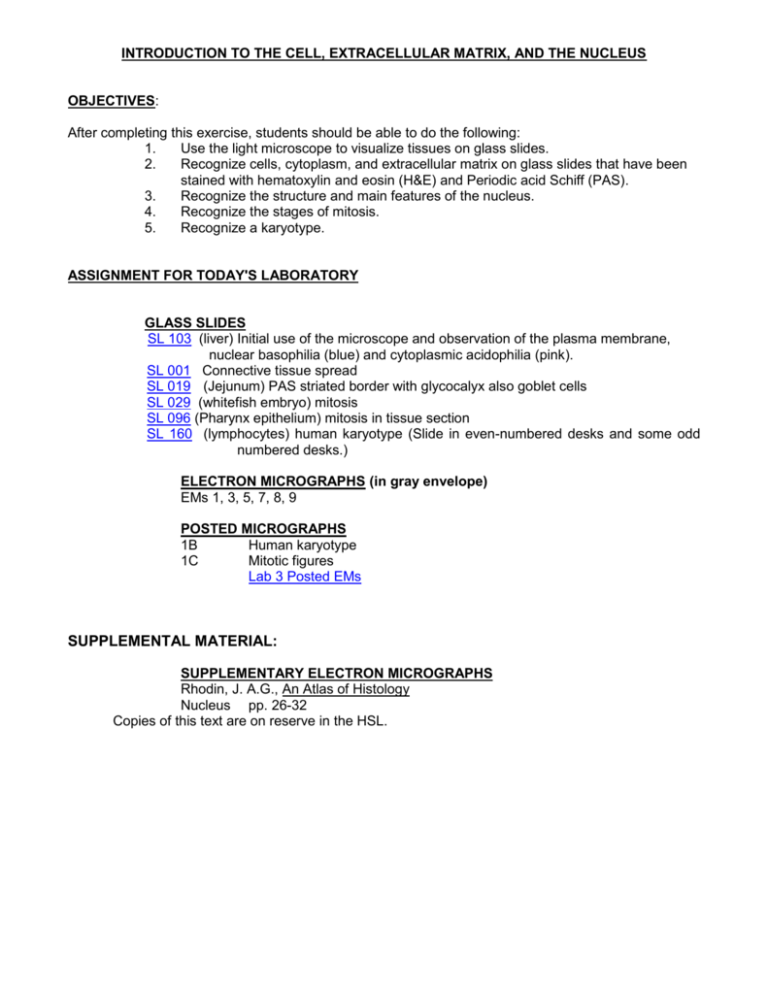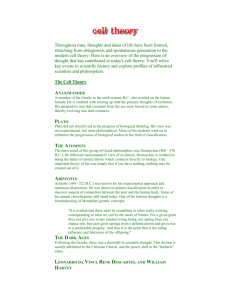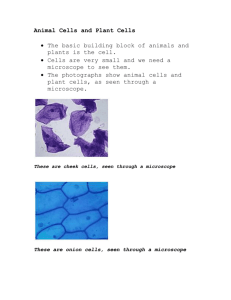VIRTUAL LABORATORY MANUAL (VLM)
advertisement

INTRODUCTION TO THE CELL, EXTRACELLULAR MATRIX, AND THE NUCLEUS OBJECTIVES: After completing this exercise, students should be able to do the following: 1. Use the light microscope to visualize tissues on glass slides. 2. Recognize cells, cytoplasm, and extracellular matrix on glass slides that have been stained with hematoxylin and eosin (H&E) and Periodic acid Schiff (PAS). 3. Recognize the structure and main features of the nucleus. 4. Recognize the stages of mitosis. 5. Recognize a karyotype. ASSIGNMENT FOR TODAY'S LABORATORY GLASS SLIDES SL 103 (liver) Initial use of the microscope and observation of the plasma membrane, nuclear basophilia (blue) and cytoplasmic acidophilia (pink). SL 001 Connective tissue spread SL 019 (Jejunum) PAS striated border with glycocalyx also goblet cells SL 029 (whitefish embryo) mitosis SL 096 (Pharynx epithelium) mitosis in tissue section SL 160 (lymphocytes) human karyotype (Slide in even-numbered desks and some odd numbered desks.) ELECTRON MICROGRAPHS (in gray envelope) EMs 1, 3, 5, 7, 8, 9 POSTED MICROGRAPHS 1B Human karyotype 1C Mitotic figures Lab 3 Posted EMs SUPPLEMENTAL MATERIAL: SUPPLEMENTARY ELECTRON MICROGRAPHS Rhodin, J. A.G., An Atlas of Histology Nucleus pp. 26-32 Copies of this text are on reserve in the HSL. Today you will use the light microscope to observe the cell membrane and the appearance of the cytoplasm and the nucleus of cells in sections of tissue that have been stained with hematoxylin and eosin (H and E) and periodic acid Schiff (PAS). We will also look in more detail at the nucleus, including mitosis. As you look at the slides with the different objectives of your microscope, make changes in the light adjustment and diaphragm to see how the image is affected. During your study, as questions arise check with your lab instructors. This exercise will introduce you to use of your microscope. In the next laboratory session you will begin to analyze electron micrographs. THIS VIRTUAL LABORATORY MANUAL CONTAINS ADDRESSES (URL’S) FOR DIGITAL IMAGES OBTAINED FROM OUR SLIDE COLLECTION THAT WILL AID YOU IN ANALYZING THE SECTIONS ON THE GLASS SLIDES. ALSO, THERE ARE REFERENCES TO ILLUSTRATIVE MATERIAL IN YOUR TEXTBOOKS WHICH CAN BE USED DURING THE LABORATORY SESSION OR AT ANOTHER TIME. ATLAS: R = ROSS AND PAWLINA, Histology: A Text and Atlas, 6th ed., 2011. TEXT: J = JUNQUEIRA, et al., Basic Histology, 13th ed., 2013 EM = Electron micrograph from gray envelope in desk drawer Electron micrograph in gray envelope in desk drawer (e.g. EM 20-2 means item or area designated 2 in electron micrograph #20) CELLS, PLASMA MEMBRANE, NUCLEUS, AND CYTOPLASM SL 103 (Liver, H&E) (J. Fig. 16-12 and 16-13a; R. Plate 65 and 66). This slide was stained with Hematoxylin and Eosin (H&E), the most common stain used in histology and pathology. Negatively charged molecules such as DNA and RNA stain with hematoxylin and appear blue. Because hematoxylin is a basic die, molecules that stain with hematoxylin are referred to as basophilic. Positively charged molecules, such as most proteins, stain with eosin, appear pink, and are referred to as eosinophilic. Generally speaking, a tissue stained with H&E will show blue nuclei and pink cytoplasm and extracellular components. However, note that some cells have substantial rRNA in the cytoplasm, either as free ribosomes (e.g. developing red blood cells) or as rough endoplasmic reticulum (e.g. plasma cells). In these cases, the cytoplasm will be stained blue with hematoxylin as well as pink with eosin, creating a purple color – a feature referred to as cytoplasmic basophilia. We will look at cytoplasmic basophilia in subsequent labs. On this slide, the area of interest is the liver, which is the large, dark tissue in the upper right portion of the digital slide. In this organ the predominant cell type is the liver cell (red circle). In these cells, the cytoplasm is pale pink and the nuclei are round and stained deep blue. Close examination of the cytoplasm reveals clear areas; these are locations previously occupied by glycogen, which washes away during tissue preparation. Fine dark lines separate the lightly stained areas of cytoplasm in adjacent cells (blue arrows); these represent the adjacent plasma membranes of the two cells. NOTE: The width of a single plasma membrane (9 nm) is below the limit of resolution of the light microscope, since under optimal conditions a structure must have a width or diameter of about 200nm to be observed. However, when two plasma membranes are juxtaposed and/or when cytoplasmic proteins have been precipitated (fixed) against the membranes, their general location can be determined as a dark line as in this slide. The tissue that lies between the cells is extracellular matrix. However, in this liver specimen, the large clear spaces you see are blood vessels, which, as you probably know, include endothelial cells and blood cells. To appreciate extracellular matrix better, observe SL 001 (connective tissue spread, elastic stain). The details of the staining methodology used here are not critical at this point; suffice it to say that the staining is similar to H&E. In this slide, the cells are more loosely organized, with more substantial extracellular matrix. (unlabeled image) (image with labels; green outline is one cell; black outline is the nucleus of that cell; blue outline is three cells; extracellular matrix is everything between cells) SL 019 (Jejunum, PAS) (J. Fig. 15-23 and 15-24a,b) This slide (low, med) was stained with the Periodic acid Schiff (PAS) method, which specifically stains carbohydrates a bright magenta. The slide was counterstained to show nuclei in blue. As you know, the plasma membrane of cells contains glycoproteins. The carbohydrate component of these glycoproteins is referred to as the glycocalyx, which, in these cells, is thicker on the apical side of the cells (the side facing the space, which is the lumen of the intestine) (oil). This is due to the fact that this apical plasma membrane in these cells contains numerous microvilli, which we will learn about later. There are also goblet cells, which contain mucus-containing granules in their cytoplasm. (microvilli with glycocalyx, blue arrow; glycocalyx on lateral cell membranes, green arrows; goblet cell, red arrow). Other details of this slide are not relevant at this time. NUCLEUS 1. INTERPHASE NUCLEUS A. Light Microscope (J. Fig. 3-1; R. Plate 66) - SL 103 - (Liver, H&E) Return to slide 103, and observe the numerous liver cell nuclei (circular areas darkly-stained with hematoxylin) (med, oil). Most of the cells have a single nucleus. Try to find a cell with two nuclei. Identify the boundary of a nucleus (a dark line). Remember that the nucleus is bounded by a nuclear envelope consisting of two adjacent membranes that are penetrated by many nuclear pores. The irregularly shaped basophilic masses within the nuclei are heterochromatin. Unstained regions are euchromatin (J. Fig. 3-1). What is the functional difference? As you study the nuclei of several cells, you will find that many nuclei contain a small, distinct, round body in addition to the dispersed chromatin. This structure is the nucleolus, (red arrows). What is its composition? EM = Electron micrograph from gray envelope in desk drawer Electron micrograph in gray envelope in desk drawer (e.g. EM 20-2 means item or area designated 2 in electron micrograph #20) B. 2. Electron Microscope - (J. Figs. 3-2, 3-3, 3-4, 3-5, 3-6, 3-11; R. Figs. 3.1, 3.4, 3.5, 3.6, 3.7). Observe the nucleus and nuclear envelope in EM 7-6 and nuclear pores in EM 8-5. Note the arrangement of chromatin into heterochromatin EM 1-8, 7-1, 8-1, and euchromatin 1-11, 7-2, 8-2. The nucleolus (J. Fig. 3-12; R. Fig. 3.4) is demonstrated in EM 1-9, 3-2. Further detail is shown in EM 7 (7-3, 7-4, 7-5), but we do not require you to identify the different regions of the nucleolus. What is the function of the nucleus and nucleolus? What is the significance of a cell with abundant heterochromatin in the nucleus? A cell with abundant euchromatin? What is the significance of prominent or multiple nucleoli? MITOSIS (J. Figs. 3-12 to 3-16; R. Figs. 3.12 to 3.16) SL 029 First scan the slide under low power. You will find several sections of a whitefish embryo. The individual cells are large and clearly delineated. Many of the cells are in interphase; each of these cells displays a well-defined, darkly staining nucleus. If you examine the sections carefully, you will be able to identify cells in various stages of mitotic division. These will be examined in more detail with the 40X objective and then with the 100X oil immersion objective. Many of these cells also contain some yolk material that is eosinophilic and appears as large round droplets. Switch to 40X objective and focus. Once you have the image in focus at 40X, rotate the objective head “between” the 40X and 100X objective, add a drop of oil to your slide, and then move the 100X objective over the slide. It usually helps to swing the 100X objective back and forth slightly through the oil a couple of times to disperse the oil evenly At this time, your image should be close to being in focus, with only minor adjustment to your fine focus necessary to bring the image into view. WARNING: ONCE THERE IS OIL ON THE SLIDE, BE CAREFUL NOT TO SWITCH BACK TO THE 40X (HIGH DRY) OBJECTIVE WITHOUT FIRST REMOVING THE IMMERSION OIL FROM THE SLIDE. IF OIL GETS ON THE 40X OBJECTIVE, IT WILL NOT FOCUS PROPERLY WITHOUT CAREFUL CLEANING. TO CLEAN YOUR 40X OBJECTIVE LENSES, USE LENS PAPER AND GLASS CLEANER. DO NOT USE KIMWIPES OR PAPER TOWELS!!!. ALSO NOTE THAT THE LENS IS CONCAVE, SO YOU MAY NEED TO ROLL UP THE LENS PAPER INTO A FINE POINT. IF YOU NEED HELP, ASK AN INSTRUCTOR TO SHOW YOU THE PROPER PROCEDURES FOR LENS CLEANING. Scan the sections for the following: (a) Interphase nuclei: Note that the nuclear material (chromatin) is bounded by a nuclear membrane (envelope). (b) Prophase (Prophase): This stage is somewhat difficult to discern. The nuclear membrane (envelope) is becoming disrupted and less distinct in late prophase and may no longer be apparent. The chromatin is undergoing reorganization and should contain multiple fibrillar strands, which will condense further to become identifiable chromosomes. (c) Metaphase (Metaphase): In metaphase there is no evidence at all of a nuclear membrane. The chromosomes are condensed and centrally aligned. The mitotic spindle is clearly evident. The microtubules of the spindle converge at the pole, at a site called the centrosome, which contains a pair of centrioles. (The centrioles are not visible at this magnification). The microtubules in this region include 1) microtubules that attach to the chromosomes at kinetochores, 2) nonkinetochore microtubules that overlap with microtubules from the opposite pole and, 3) astral microtubules that radiate out from the centrosome and participate in the orientation of the mitotic spindle. Remember that you will encounter many different orientations; some metaphase cells will be viewed from above, others from the side. (d) Anaphase (anaphase): At this stage the chromosomes are separating towards opposite poles. Again, there is no nuclear membrane. Mitotic spindles and asters (formed of astral microtubules) are clearly apparent. (e) Telophase (early, late, telophase): The chromosomes have now completely separated, and a new cell membrane should have appeared between the sets of chromosomes to define the limits of the two daughter cells. The chromosomes become more compact, may appear to fuse with one another, and are no longer clearly discernable from one another. Formation of a new nuclear membrane should follow shortly. Sometimes remnants of the mitotic spindle are visible at this stage. SL 096 - (Pharynx) Mitosis in tissue sections. (J. 3-16) In the previous slide, the individual stages of mitosis were readily apparent. In most H&E sections, however, we can only discriminate between cells in interphase, and cells that are in mitosis. These cells in mitosis are referred to as simply mitotic figures. It is possible to “guess” the phase of mitosis of a mitotic figure, but this is not necessary. Simply appreciate that many tissues in the body (e.g. epidermis of the skin) are undergoing constant regeneration, and, in these tissues, mitotic figures are readily observed. In this slide from the pharynx, the surface tissue (an epithelium) contains multiple layers of cells. First, be certain that you are looking in the proper region of the slide which includes the epithelium. (low, med). Once in the proper region, note that most epithelial nuclei look similar to those from the liver cell; these cells are in interphase. Then, carefully search for cells lacking a defined nucleus, but containing condensed chromatin; these are mitotic figures. (high, red circles). The presence of an increased number of mitotic figures in tissue sections can be used as an indication that a tissue contains cancer cells. 3. KARYOTYPE SL 160 - (MAY BE ABSENT FROM SOME DESKS) Human Chromosomes - (J. Fig. 3-10; R. Folder. 3.1). Karyotype preparation (high, oil). This karyotype was obtained by isolating lymphocytes from blood and stimulating them to undergo mitosis by exposure to phytohemagglutinin. Colchicine was added to the preparation to prevent formation of the mitotic spindle and arrest mitosis at metaphase. Only a few cells were in mitosis when the preparation was made, therefore you will have to look through the slide carefully to find a karyotype that is complete. Obviously, specific chromosome identification is not reasonable with our microscopes, but understand that this can be done routinely, and that more powerful techniques such as fluorescence in situ hybridization (FISH) and spectral karyotyping (SKY) are available (see text for details). SPECIFIC OBJECTIVES FOR INTRODUCTION TO THE CELL, EXTRACELLULAR MATRIX, AND THE NUCLEUS 1. Make sure you are familiar with the use of your light microscope and the digital slides, including changing magnification, light intensity, etc. Practical exams will include both. 2. Using the light microscope or digital slides, identify: Cells Plasma membrane Nucleus Cytoplasm Extracellular material 3. Have a good understanding of typical staining techniques. a. Recognize hematoxylin and eosin (H&E) staining (e.g. SL 103), and know how parts of the cells, tissues, and organs stain with this technique. For example, for today’s lab, how do each of the structures listed under #2 above appear on H&E staining? What is meant by the terms basophilic and eosinophilic, and which structures in the cell are basophilic? Eosinophilic? You will want to do this for each item listed in the objective section under light microscope identification in all future labs. Also, note you will find that different cell types stain slightly differently with H&E, so you also should recognize those as they are introduced. b. Recognize slides stained with Periodic acid-Schiff (PAS), and know which components of cells and the extracellular matrix stain positively using this method. c. Throughout your course blocks and in exams, you may be presented with tissues stained by other techniques. In these cases, you will either be given specifics on the staining technique used if necessary, or will be asked questions that do not depend on knowledge of the exact nature of the staining technique. For example, for the most part, you should recognize the nucleus of a cell regardless of which staining technique is used (as long as you can see it). 4. Using the light microscope or digital slides, identify: Nuclear membrane Heterochromatin Euchromatin Nucleolus Stages of the cell cycle (specific stages best seen whitefish embryo) Interphase Prophase Metaphase Anaphase Telophase Mitotic spindle Interphase nuclei (in tissues) Mitotic figures (in tissues it is sometimes difficult to distinguish specific stages of mitosis) Karyotype 5. On electron micrographs, identify: Nuclear envelope Nuclear pore Heterochromatin Euchromatin Nucleolus









